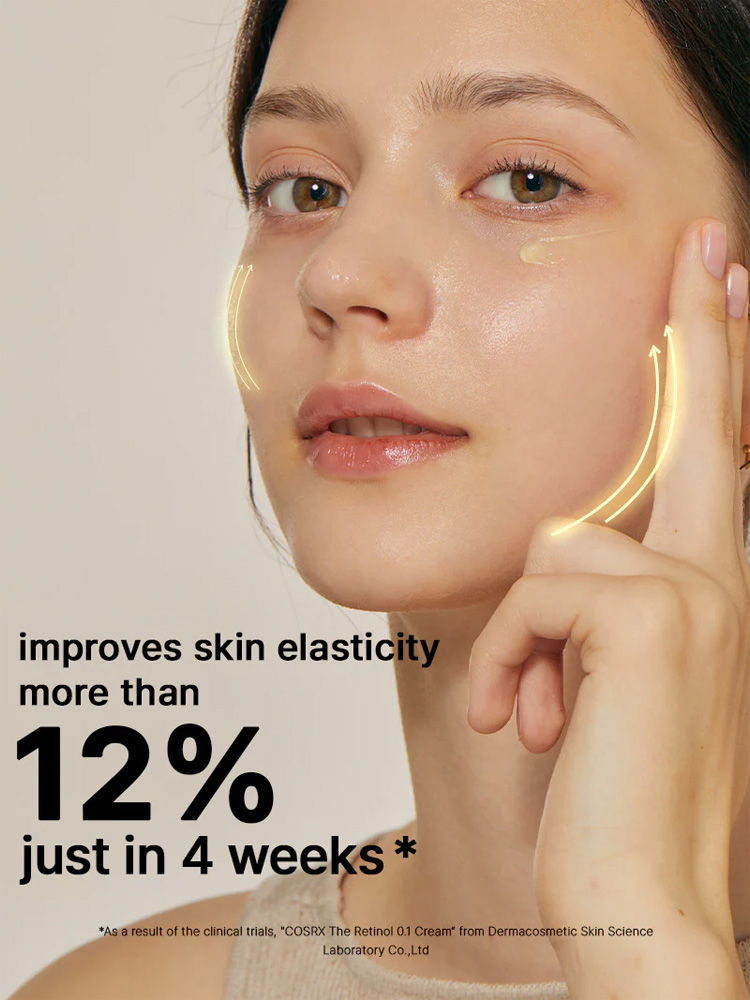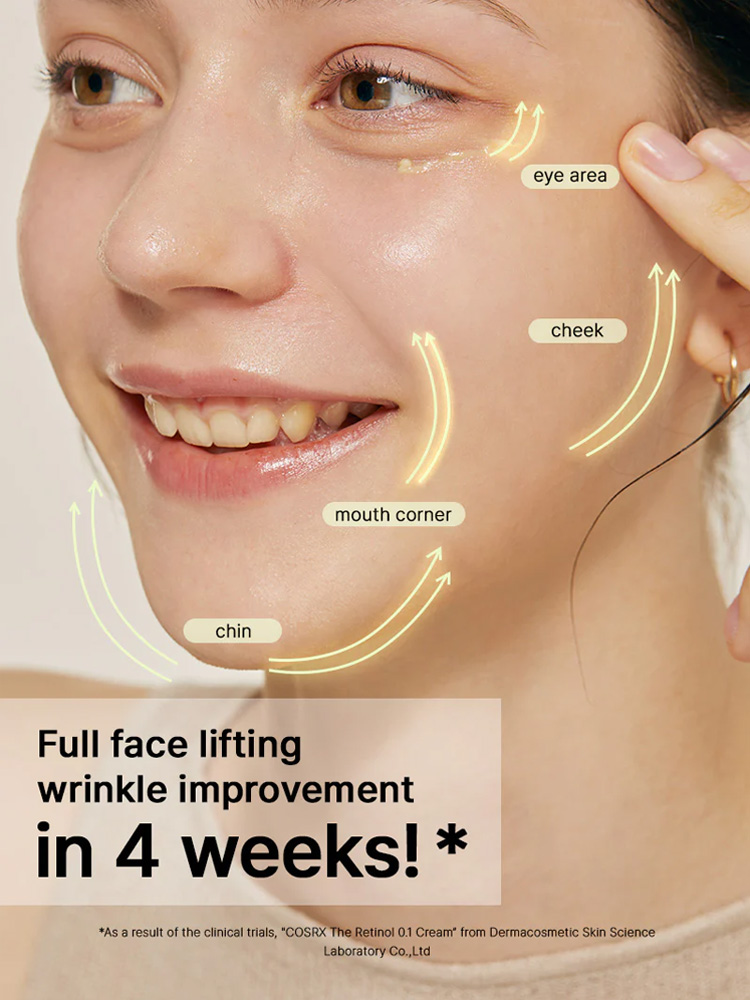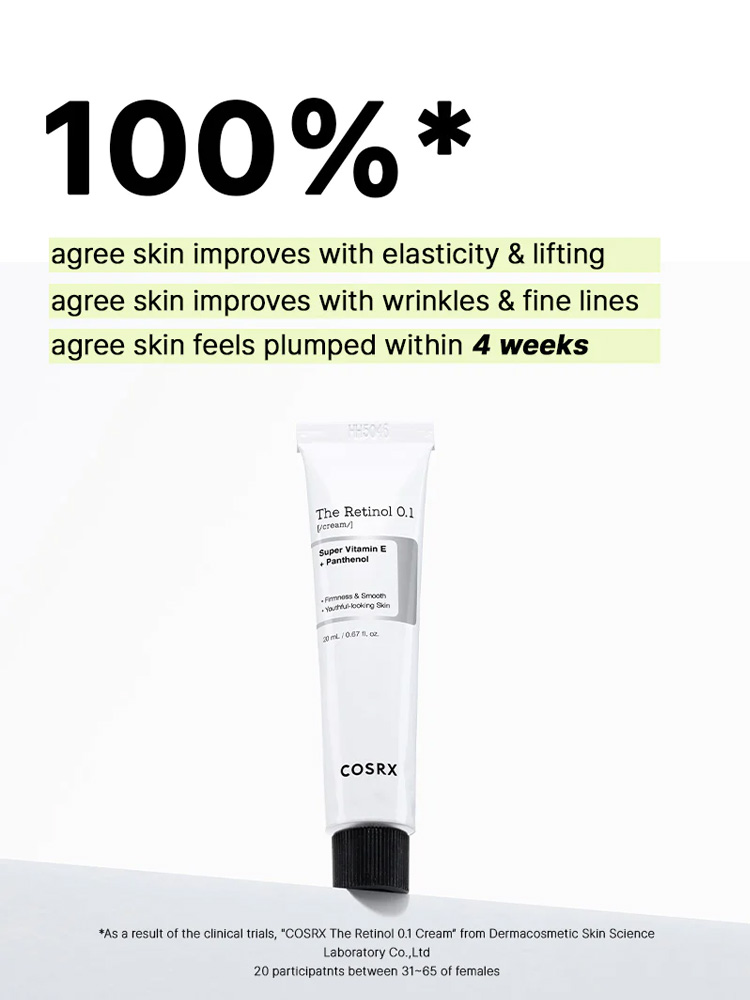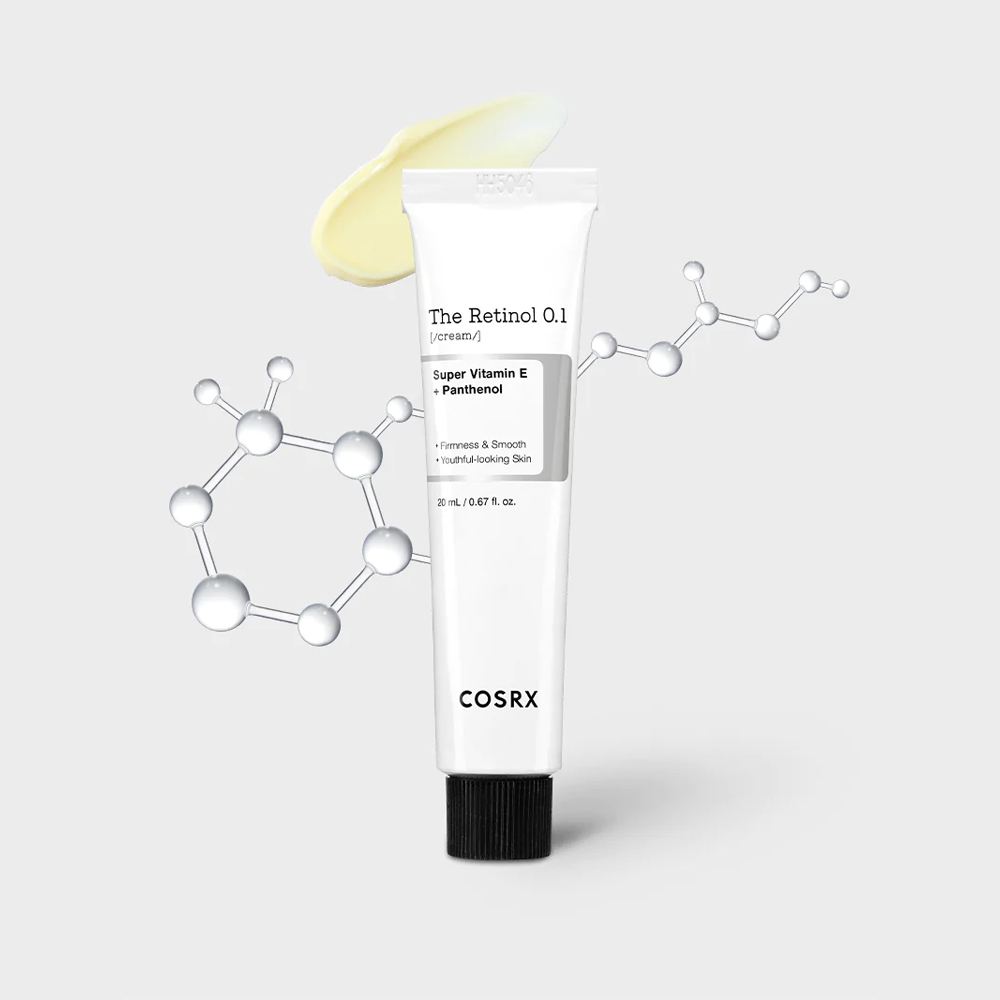Clinical Results in 4 weeks
*Suitable for acne-prone skin use (Non-comedogenic).
– 18.62% improvement of wrinkles(forehead)
– 18.32% improvement of wrinkles(nasolabial)
– 16.25% improvement of wrinkles(eye area)
– 12.81% improvement of elasticity (external elasticity)
– 12.66% improvement of lifting (mouth corner)
– 10.30% improvement of lifting (chin)
– 4.16% improvement of skin age
Clinical Results in 2 weeks
– 45.14% improvement of pore (volume)
– 42.07% improvement of pore (area)
*Based on clinical trials of 20 subjects.
*Dermacosmetic Skin Science Laboratory Co., Ltd.
• Pure retinol (Vitamin A) :
Decreases wrinkles and fine lines
• Panthenol :
Protects and moisturizes skin from external stimuli
• Adenosine :
Skin cell activation. Improves elasticity and wrinkles
• Tocotrienol (Super Vitamin E) :
Reduces visible signs of aging and skin damage
Q. How does Retinol do to your skin?
Wrinkles and loss of skin elasticity are caused by decreased collagen production and skin elasticity in the dermis which is part of the structure of the skin. Collagen naturally decreases due to environmental factors such as aging and UV rays. Retinol will deliver visible results in wrinkles by stimulating collagen gene and synthesis in the dermis.
Q. Do you need to wash retinol off in the morning?
Retinol is weak against light and heat; we recommend using it at night. If applied during the daytime, be sure to use with a SPF. (* It is recommended to apply a SPF even if not applied during the daytime. Because it can be still left on skin in the next day.
Q. Who should not use retinol?
It is suitable for those who have concerns about aging (wrinkles, low elasticity) but not recommended during pregnancy and breastfeeding. Please do not use it after non-surgical cosmetic procedure and using beauty equipment.
Q. What can you not mix with retinol?
Retinol with vitamin C, benzoyl peroxide, and AHA/BHA acids. AHA and BHA acids are exfoliating, which can dry out skin and cause further irritation if your skincare routine already includes retinol.
Q. It stings and turns red. Is it supposed to be like this?
A high concentration of niacinamide can cause skin irritation such as redness and itching, however it’s not harmful effects but it’s burning accompanied by blood vessels to widen. It has nothing to do with skin problems.
Retinol can cause side effects skin irritations, erythema, skin peeling. It is recommended to use a small amount every other week during an adjustment period then increase it gradually.
** CAUTIONS
• Patch testing prior to use is advised.
• When pregnant or breastfeeding, it is recommended to avoid any retinoid products.
• After the use of retinol, the skin may feel stingy and may show signs of reddening due to deep skin exfoliation. Irritation is a temporary and normal symptom. If irritation persists, reduce the frequency or stop the use of the product.
• Due to the nature of the retinol component, the color may become darker or you may feel a unique odor.
• To maintain the freshness of retinol ingredients, avoid storing in high temperatures and direct sunlight.
• It is recommended to store it in the refrigerator when not used every day.
• Since this product can increase sensitivity to sunlight, use sunscreen while using the product.
• Do not pair with any scrub, peeling or exfoliating product as it can irritate the skin


START SMALL AND SLOW!
• After using essence or serum, pat a small amount using your ring finger. Apply evenly over the face, neck, and onto parts with wrinkle concerns.
• Limit initial use to three times per week; gradually increase frequency to every other night, use as tolerated.
* Have an ‘adaption period’ when using retinol
WEEK 1~2
• Frequency : use every other day at night
• How to Use : After cleansing, at the moisturizer step, apply a small amount to areas of concern.
• e.g. under eyes, mouth, forehead and neck
(Recommended amount : 0.1ml per section / 1 grain of rice)
WEEK 3~
• Frequency : may apply everyday at night
• How to use : After cleansing, at the moisturizer step, may spread over the entire face.
* The “building tolerance” phase can be shortened or extended depending on individual differences.
* Maintain this phase until no discomfort is experienced.
* Gradually increase frequency and areas of application



![[COSRX] Hydrium Green Tea Aqua Soothing Gel Cream](https://kbeautykenya.com/wp-content/uploads/2023/07/COSRX-Green-Tea-Aqua-soothig-gel-300x300.jpg)
![[COSRX] Hyaluronic Acid Intensive Cream](https://kbeautykenya.com/wp-content/uploads/2019/06/cosrx-hyaluronic-acid-intensive-cream_1-300x300.jpg)
![[Nature Republic] Soothing & Moisture Aloe Vera 92% Soothing Gel](https://kbeautykenya.com/wp-content/uploads/2024/07/Nature-repbulic-Aloe-vera-92-300x300.jpg)
![[BENTON] Aloe Propolis Soothing Gel](https://kbeautykenya.com/wp-content/uploads/2020/01/1-300x300.jpg)